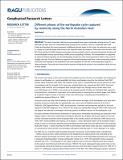DSpace Repository
Different phases of the earthquake cycle captured by seismicity along the North Anatolian Fault
- DSpace Home
- →
- Web Of Science
- →
- Web Of Science
- →
- View Item
JavaScript is disabled for your browser. Some features of this site may not work without it.
| dc.contributor.author | Bulut, Fatih
|
|
| dc.date.accessioned | 2024-03-05T10:26:46Z | |
| dc.date.available | 2024-03-05T10:26:46Z | |
| dc.date.issued | 2015 | |
| dc.identifier.issn | 0094-8276 | |
| dc.identifier.issn | 1944-8007 | |
| dc.identifier.uri | http://hdl.handle.net/11547/11141 | |
| dc.description.abstract | The North Anatolian Fault has accommodated three major earthquakes during the last 15years. Although the fault zone has substantially failed during the last century, it did not completely fail in NW Turkey and therefore left several segments at different physical stages. In this study, the seismicity rate is used as a proxy to locate the brittle fault sections with high/low strain accumulation. The results show that the 1999 M7.4 zmit and the 2014 M6.9 Aegean earthquakes were preceded by almost a decade-long period of enhanced microearthquake activity representing a brittle process preparing the failure. This interpretation is supported by observed lateral migration of microearthquakes toward the main shock hypocenter within a time scale of roughly a decade. The Sea of Marmara segments of the North Anatolian Fault show a rather temporally uniform seismicity trend leading to the hypothesis that those segments are still not in the preparation stage for a large earthquake. The results also show that the duration of aftershock activity is not controlled only by the size of main shocks. | tr_TR |
| dc.language.iso | en | tr_TR |
| dc.relation.ispartofseries | 42;7 | |
| dc.subject | DEFORMATION | tr_TR |
| dc.subject | NUCLEATION | tr_TR |
| dc.title | Different phases of the earthquake cycle captured by seismicity along the North Anatolian Fault | tr_TR |
| dc.type | Article | tr_TR |
Files in this item
This item appears in the following Collection(s)
-
Web Of Science [1012]
